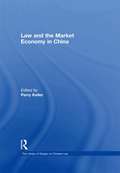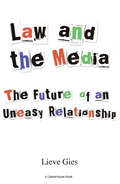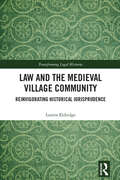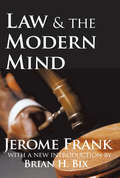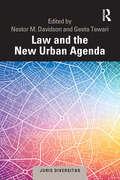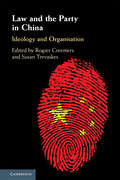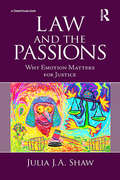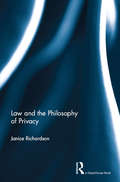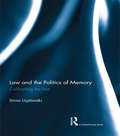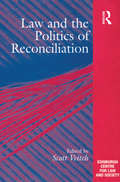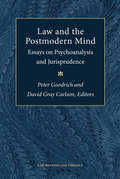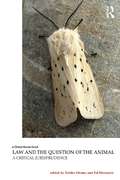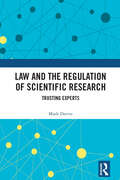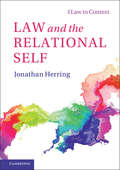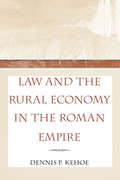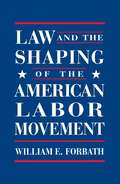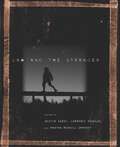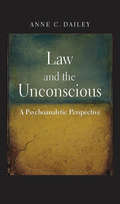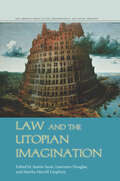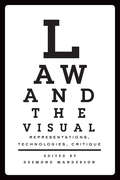- Table View
- List View
Law and the Market Economy in China (The\library Of Essays On Chinese Law Ser.)
by Perry KellerThis volume concerns several aspects of China's changing market based economy. These include commercial contract enforcement, corporate structures, competition law and other issues related to China's membership in the WTO. In the past two decades, the rapid integration of China's economy into the global marketplace has created obligations and expectations of non-discrimination and regulatory transparency in domestic markets. The Chinese government has responded by demanding better governance within major companies, market sectors and public administration generally. However, as the articles in this volume show, it has struggled to find a corporate structure capable of absorbing external equity investment and participation but still amenable to direct and indirect state guidance. It has also moved cautiously in creating legal controls over unfair competition. Moreover, the protection of state owned enterprises, which serve as vehicles for domestic economic, social and political policy, has been a recurring issue in China's WTO trade disputes.
Law and the Media: The Future of an Uneasy Relationship
by Lieve GiesIntroducing readers to the study of law, media and popular culture, this text, using three original case studies, re-examines the assumptions underpinning existing research and suggests alternatives. Arguing that the study of law, media and popular culture should be embedded in the sociology of everyday life, the author focuses on four specific topics, in which there is scope for further development. These are the facts that: the current literature in this field predominantly focuses on crime, neglecting the way the media portrays less spectacular, more run-of-the-mill legal topics fiction, primarily, has captured scholars' attention, with remarkably less being paid to representations of law, other than crime, in factual media textual analysis continues to be the preferred method in the study of law and the media the literature is dominated by a fear of corrosive media effects, while the potential of the media and popular culture to improve public legal knowledge, facilitate access to justice and promote legal change remains largely undocumented. Exploring the often uneasy relationship between law and popular culture from specific socio-legal perspectives, including systems theory, semiotics of law and legal pluralism, this book is an essential read for those studying and researching in this area.
Law and the Medieval Village Community: Reinvigorating Historical Jurisprudence (Transforming Legal Histories)
by Lorren EldridgeThis book expands on established doctrine in legal history and sets out a challenge for legal philosophers. The English medieval village community offers a historical and philosophical lens on the concept of custom which challenges accepted notions of what law is. The book traces the study of the medieval village community from early historical works in the nineteenth century through to current research. It demonstrates that some law-making can and has been ‘bottom-up’ in English law, with community-led decisionmaking having a particularly important role in the early common law. The detailed consideration of law in the English village community reveals alternative ways of making and conceiving of law which are not dependent on state authority, particularly in relation to customary and communal property rights. Acknowledging this poses challenges for legal theory: the legal positivism that dominates Western legal philosophy tends to reject custom as a source of law. However, this book argues that medieval customary law ought to be considered ‘law’ if we are ever going to fully understand law – both then and now. The book will be a valuable resource for researchers and academics working in the areas of Legal History, Legal Theory, and Jurisprudence.
Law and the Modern Mind
by Brian H. Bix Jerome FrankLaw and the Modern Mind first appeared in 1930 when, in the words of Judge Charles E. Clark, it "fell like a bomb on the legal world." In the generations since, its influence has grown-today it is accepted as a classic of general jurisprudence.The work is a bold and persuasive attack on the delusion that the law is a bastion of predictable and logical action. Jerome Frank's controversial thesis is that the decisions made by judge and jury are determined to an enormous extent by powerful, concealed, and highly idiosyncratic psychological prejudices that these decision-makers bring to the courtroom.
Law and the Modern Mind
by Brian H. Bix Jerome FrankLaw and the Modern Mind first appeared in 1930 when, in the words of Judge Charles E. Clark, it "fell like a bomb on the legal world." In the generations since, its influence has grown-today it is accepted as a classic of general jurisprudence.The work is a bold and persuasive attack on the delusion that the law is a bastion of predictable and logical action. Jerome Frank's controversial thesis is that the decisions made by judge and jury are determined to an enormous extent by powerful, concealed, and highly idiosyncratic psychological prejudices that these decision-makers bring to the courtroom.
Law and the Modern Mind: Consciousness and Responsibility in American Legal Culture
by Susanna L. BlumenthalHeadline-grabbing murders are not the only cases in which sanity has been disputed in the American courtroom. Susanna Blumenthal traces this litigation, revealing how ideas of human consciousness, agency, and responsibility have shaped American jurisprudence as judges struggled to reconcile Enlightenment rationality with new sciences of the mind.
Law and the New Logics
by Smith Glenn H. Patrick Lionel D.This book is unique in presenting an interdisciplinary conversation between jurists and logicians. It brings together scholars from both law and philosophy and looks at the application of 'the new logics' to law and legal ordering, in a number of legal systems. The first Part explores the ways in which the new logics shed light on the functioning of legal orders, including the structure of legal argumentation and the rules of evidence. The second addresses how non-classical logics can help us to understand the interactions between multiple legal orders, in a range of contexts including domestic and international law. The final Part examines particular issues in the applicability of non-classical logics to legal reasoning. This book will be of interest to jurisprudence and logic scholars and students who want to deepen their understanding of relationships between law and legal reasoning, and learn about recent developments in formal logic.
Law and the New Urban Agenda: A Comparative Perspective (Juris Diversitas)
by Nestor M. Davidson Geeta TewariThe New Urban Agenda (NUA), adopted in 2016 at the United Nations Conference on Housing and Sustainable Urban Development (Habitat III) in Quito, Ecuador, represents a globally shared understanding of the vital link between urbanization and a sustainable future. At the heart of this new vision stand a myriad of legal challenges – and opportunities – that must be confronted for the world to make good on the NUA’s promise. In response, this book, which complements and expands on the editors’ previous volumes on urban law in this series, offers a constructive and critical evaluation of the legal dimensions of the NUA. As the volume’s authors make clear, from natural disasters and resulting urban migration in Honshu and Tacloban, to innovative collaborative governance in Barcelona and Turin, to accessibility of public space for informal workers in New Delhi and Accra, and power scales among Brazil’s metropolitan regions, there is a deep urgency for thoughtful research to understand how law can be harnessed to advance the NUA’s global mission of sustainable urbanism. It thus creates a provocative and academic dialogue about the legal effects of the NUA, which will be of interest to academics and researchers with an interest in urban studies.
Law and the Party in Xi Jinping's China: Ideology and Organization
by Susan Trevaskes Rogier CreemersIn the Xi Jinping era, it has become clear that the rule of law, as understood in the West, will not appear in China soon. But was this ever a likely option? This book argues China's legal system needs to be studied from an internal perspective, to take into account the characteristic architecture of China's Party-state. To do so, it addresses two key elements: ideology and organisation. Part One of the book discusses ideology and the law, exploring how the Chinese Communist Party conceives of the nature of law and its position within its broader range of policy tools. Part Two, on organisation and the law, reviews how these ideological principles manifest themselves in the application of law, as well as the reform of the Party-state. As such, it highlights how the Party's plans and approaches run counter to mainstream theoretical expectations, and advocates a greater attention to the inherent logic of the system itself.
Law and the Passions: Why Emotion Matters for Justice
by Julia J.A. ShawEngaging with the underlying social context in which emotions are a motivational force, Law and the Passions provides a uniquely inclusive commentary on the significance and influence of emotions in the history and continuing development of legal judgment, policy formation, legal practice and legal dogma. Although the emotionality of the law and the use of emotional tropes in legal discourse has become an established focus in recent scholarship, the extent to which emotion and the passions have informed decision-making, decision-avoidance and legal reasoning – rather than as simply an adjunct – is still a matter for critical analysis. As evidenced in a range of illustrative legal cases, emotions have been instrumental in the evolution of key legal principles and have produced many controversial judgments. Addressing the latent influence of fear, hate, love and compassion, the book explores the mutability of law and its transformative power, especially when faced with fluctuating social mores. The textual nature of law and the impact of literary forms on legal actors are also critically examined to further elucidate the idea of law-making as both rational and emotional, and significantly as an essential activity of the empathic imagination. To this end, it is suggested that critical scholarship on law, the passions and emotions not only advances our understanding of the inner workings of law, it constitutes a fundamental part of our moral reasoning, and has the capacity to articulate the conditions for a more dynamic, adaptable, ethical and effective legal institution. This interdisciplinary book will be of interest to scholars and students in the fields of law and literature, legal theory, legal philosophy, law and the humanities, legal aesthetics, sociology of law, politics, law and policy, human rights, general jurisprudence and social justice, as well as cultural studies.
Law and the Philosophy of Privacy
by Janice RichardsonSituating privacy within the context of political philosophy, this book highlights the way in which struggles concerning the meaning of privacy have always been political. Different conceptions of privacy are here shown to involve diverse assumptions about ontology: our conceptions of self, culture, society and communication. Privacy theory’s debt to Locke, Kant or Mill, and what is at stake in their conceptual frameworks, is examined. The extent to which the term "privacy" has been used to the detriment of - and to create - weaker parties in marriage, in the workplace and now as citizens (or non-citizens) and consumers, as well as employees, is also demonstrated. In contrast, Janice Richardson pursues the relevance of Floridi’s philosophy of information, before turning to her application of Spinoza, the philosopher of communication, in order to outline a more useful framework through which to think about privacy today. The book will be of interest to those working in political philosophy, feminist philosophy, law, the philosophy of information, sociology, media, and cultural studies.
Law and the Politics of Memory: Confronting the Past
by Stiina LoytomakiLaw and the Politics of Memory: Confronting the Past examines law’s role as a tool of memory politics in the efforts of contemporary societies to work through the traumas of their past. Using the examples of French colonialism and Vichy, as well as addressing the politics of memory surrounding the Holocaust, communism and colonialism, this book provides a critical exploration of law’s role in ‘belated’ transitional justice contexts. The book examines how and why law has become so central in processes in which the past is constituted as a series of injustices that need to be rectified and can allegedly be repaired. As such, it explores different legal modalities in processes of working through the past; addressing the implications of regulating history and memory through legal categories and legislative acts, whilst exploring how trials, restitution cases, and memory laws manage to fulfil such varied expectations as clarifying truth, rendering homage to memory and reconciling societies. <P><P> Legal scholars, historians and political scientists, especially those working with transitional justice, history and memory politics in particular, will find this book a stimulating exploration of the specificity of law as an instrument and forum of the politics of memory.
Law and the Politics of Reconciliation (Edinburgh/glasgow Law And Society Ser.)
by Scott VeitchThis collection of essays by an international group of authors explores the ways in which law and legal institutions are used in countries coming to terms with traumatic pasts and, in some cases, traumatic presents. In putting to question what is often taken for granted in uncritical calls for reconciliation, it critically analyses and frequently challenges the political and legal assumptions underlying discourses of reconciliation. Drawing on a broad spectrum of disciplinary and interdisciplinary insights the authors examine how competing conceptions of law, time, and politics are deployed in social transformations and how pressing demands for reconstruction, reconciliation, and justice inform and respond to legal categories and their use of time. The book is genuinely interdisciplinary, drawing on work in politics, philosophy, theology, sociology and law. It will appeal to a wide audience of researchers and academics working in these areas.
Law and the Postmodern Mind: Essays on Psychoanalysis and Jurisprudence
by Peter Goodrich David Carlson GrayDavid Gray Carlson and Peter Goodrich argue that the postmodern legal mind can be characterized as having shifted the focus of legal analysis away from the modernist understanding of law as a system that is unitary and separate from other aspects of culture and society. In exploring the various "other dimensions" of law, scholars have developed alternative species of legal analysis and recognized the existence of different forms of law. Carlson and Goodrich assert that the postmodern legal mind introduced a series of "minor jurisprudences" or partial forms of legal knowledge, which both compete with and subvert the modernist conception of a unitary system of law. In doing so scholars from a variety of disciplines pursue the implications of applying the insights of their disciplines to law. Carlson and Goodrich have assembled in this volume essays from some of our leading thinkers that address what is arguably one of the most fundamental of interdisciplinary encounters, that of psychoanalysis and law. While psychoanalytic interpretations of law are by no means a novelty within common law jurisprudence, the extent and possibilities of the terrain opened up by psychoanalysis have yet to be extensively addressed. The intentional subject and "reasonable man" of law are disassembled in psychoanalysis to reveal a chaotic and irrational libidinal subject, a sexual being, a body and its drives. The focus of the present collection of essays is upon desire as an inner law, upon love as an interior idiom of legality, and represents a signficant and at times surprising development of the psychoanalytic analysis of legality.
Law and the Question of the Animal: A Critical Jurisprudence (Law, Justice and Ecology #1)
by Yoriko Otomo Ed MussawirThis book addresses the problem of ‘animal life’ in terms that go beyond the usual extension of liberal rights to animals. The discourse of animal rights is one that increasingly occupies the political, ethical and intellectual terrain of modern society. But, although the question of the status of animals holds an important place within a range of civil, political and technological disciplines, the issue of rights in relation to animals usually rehearses the familiar perspectives of legal, moral and humanist philosophy. ‘Animal law’ is fast becoming a topic of significant contemporary interest and discussion. This burgeoning interest has not, however, been matched by renewed inquiry into the jurisprudential frames and methods for the treatment of animals in law, nor the philosophical issue of the ‘human’ and the ‘animal’ that lies at law’s foundation. Responding to this interest, Law and the Question of the Animal: A Critical Jurisprudence brings together leading and emerging critical legal theorists to address the question of animality in relation to law’s foundations, practices and traditions of thought. In so doing, it engages a surprisingly underdeveloped aspect of the moral philosophies of animal rights, namely their juridical register and existence. How does ‘animal law’ alter our juridical image of personality or personhood? How do the technologies of law intersect with the technologies that invent, create and manage animal life? And how might the ethical, ontological and ceremonial relation between humans and animals be linked to a common source or experience of law?
Law and the Regulation of Scientific Research: Trusting Experts
by Mark DaviesScientific research is fundamental to addressing issues of great importance to the development of human knowledge. Scientific research fuels advances in medicine, technology and other areas important to society and has to be credible, trustworthy and able to command confidence in the face of inevitable uncertainties. Scientific researchers must be trusted and respected when they engage with knowledge acquisition and dissemination and as ethical guardians in their education and training roles of future generations of researchers. The core values of scientific research transcend disciplinary and national boundaries and approaches to the organisation and oversight of research systems can impact significantly upon the ethics and conduct of researchers. This book draws upon legal expertise to critically analyse issues of regulation, conduct and ethics at the important interface between scientific research and regulatory and legal environments. In so doing it aims to contribute important additional perspectives to the existing literature. Case studies are engaged with to assist with the critical analysis of the current position and the consideration of future possibilities. The book will be of interest to academics in the fields of science, law and policy; science and law students and scientific researchers at more advanced stages of their careers. Research professionals in government and the private sector and legal practitioners with interests in the regulation of research should also find the work of interest.
Law and the Relational Self (Law in Context)
by Jonathan HerringThis book promotes a relational understanding of the self. It explores how law can be transformed by focusing on the promotion and protection of caring relationships, rather than individual rights. This offers a radical and profound re-imagining of what law is about and what it should be trying to do. It moves from the theoretical into offering practical examples of how the law could be developed to enhance relationships, rather than undermine them.
Law and the Rural Economy in the Roman Empire
by Dennis P. KehoeThe economy of the Roman Empire was predominantly agrarian: Roman landowners, agricultural laborers, and small tenant farmers were highly dependent upon one another for assuring stability. By examining the property rights established by the Roman government, in particular the laws concerning land tenure and the contractual relationships between wealthy landowners and the tenant farmers to whom they leased their land, Dennis P. Kehoe is able to demonstrate how the state fostered economic development and who benefited the most. In this bold application of economic theory, Kehoe explores the relationship between Roman private law and the development of the Roman economy during a crucial period of the Roman Empire, from the second to the fourth century C.E. Kehoe is able to use the laws concerning land tenure, and the Roman government's enforcement of those laws, as a window through which to develop a more comprehensive view of the Roman economy. With its innovative application of the methodologies of law and economics and the New Institutional Economics Law and the Rural Economy in the Roman Empire is a groundbreaking addition to the study of the Roman economy.
Law and the Shaping of the American Labor Movement
by William E. ForbathWhy did American workers, unlike their European counterparts, fail to forge a class-based movement to pursue broad social reform? Was it simply that they lacked class consciousness and were more interested in personal mobility? In a richly detailed survey of labor law and labor history, William Forbath challenges this notion of American “individualism.” In fact, he argues, the nineteenth-century American labor movement was much like Europe’s labor movements in its social and political outlook, but in the decades around the turn of the century, the prevailing attitude of American trade unionists changed. Forbath shows that, over time, struggles with the courts and the legal order were crucial to reshaping labor’s outlook, driving the labor movement to temper its radical goals.
Law and the Social Sciences: Hart And Sartre On Revolution (Studies In The Social Sciences Ser. #6)
by Leon Lipson Stanton WheelerThe notion of law as a social phenomenon would have surprised educators and scholars a century ago. For them, law was a science and the library was the ultimate source of all legal knowledge. Our contemporary willingness to see law in a social context—reflecting social relations, for example, or precipitating social changes—is a relatively recent development, spurred during the last quarter century by the work of a generation of scholars (mostly social scientists and law professors) who believe the perspectives of the social sciences are essential to a better understanding of the law. Law and the Social Sciences provides a unique and authoritative assessment of modern sociolegal research. Its impressive range and depth, the centrality of its concerns, and the stature of its contributors all attest to the vitality of the law-and-society movement and the importance of interdisciplinary work in this field. Each chapter is both an exposition of its author’s point of view and a survey of the pertinent literature. In treating such topics as law and the economic order, legal systems of the world, the deterrence doctrine, and access to justice, the authors explore overlapping themes—the tension between public and private domains, between diffused and concentrated power, between the goals of uniformity and flexibility, between costs and benefits—that are significant to observers not only of our legal institutions but of other social systems as well.
Law and the Stranger
by Austin Sarat Lawrence Douglas Martha Merrill UmphreyThe six papers presented in this collection "explore the ways in which law, particularly liberal legal regimes, identifies and responds to strangers within and across their borders, both historically and in the present day," to quote the editors (all of Amherst College). Specifically, the papers explore and critique Immanuel Kant's ideas on neighborliness and hospitality in relation to contemporary transnational migration; the ways that the historic relative legal equality of citizens and aliens in the United States has been undermined in recent years by "war on terror" policies and curtailments of public assistance to immigrants; jurisdictional boundary-drawing in the Israeli trials of Azmi Bishara, a Palestinian citizen of Israel and Knesset member, and Marwan Barghouti, a member of the Palestinian Parliament, both tried for allegedly inciting terrorism and both rejecting the jurisdiction of the Israeli criminal courts over their cases; conflict of laws and the possibility of crafting hybrid rules that blend laws across normative boundaries; George Eliot's novel Daniel Deronda and the definition of rights and privileges of Jews, women, and illegitimate children in English law; and illiberalism and antilegalism in utopian literature. Annotation ©2011 Book News, Inc. , Portland, OR (booknews. com)
Law and the Technologies of the Twenty-First Century
by Roger Brownsword Morag GoodwinLaw and the Technologies of the Twenty-First Century provides a contextual account of the way in which law functions in a broader regulatory environment across different jurisdictions. It identifies and clearly structures the four key challenges that technology poses to regulatory efforts, distinguishing between technology as a regulatory target and tool, and guiding the reader through an emerging field that is subject to rapid change. By extensive use of examples and extracts from the texts and materials that form and shape the scholarly and public debates over technology regulation, it presents complex material in a stimulating and engaging manner. Co-authored by a leading scholar in the field with a scholar new to the area, it combines comprehensive knowledge of the field with a fresh approach. This is essential reading for students of law and technology, risk regulation, policy studies, and science and technology studies.
Law and the Unconscious: A Psychoanalytic Perspective
by Anne C. DaileyHow do we bring the law into line with people’s psychological experience? How can psychoanalysis help us understand irrational actions and bad choices? Our legal system relies on the idea that people act reasonably and of their own free will, yet some still commit crimes with a high likelihood of being caught, sign obviously one-sided contracts, or violate their own moral codes—behavior many would call fundamentally irrational. Anne Dailey shows that a psychoanalytic perspective grounded in solid clinical work can bring the law into line with the reality of psychological experience. Approaching contemporary legal debates with fresh insights, this original and powerful critique sheds new light on issues of overriding social importance, including false confessions, sexual consent, threats of violence, and criminal responsibility. By challenging basic legal assumptions with a nuanced and humane perspective, Dailey shows how psychoanalysis can further our legal system’s highest ideals of individual fairness and systemic justice.
Law and the Utopian Imagination
by Austin Sarat Lawrence Douglas Martha Merrill UmphreyLaw and the Utopian Imagination seeks to explore and resuscitate the notion of utopianism within current legal discourse. The idea of utopia has fascinated the imaginations of important thinkers for ages. And yet#151;who writes seriously on the idea of utopia today? The mid-century critique appears to have carried the day, and a belief in the very possibility of utopian achievements appears to have flagged in the face of a world marked by political instability, social upheaval, and dreary market realities. Instead of mapping out the contours of a familiar terrain, this book seeks to explore the possibilities of a productive engagement between the utopian and the legal imagination. The book asks: is it possible to re-imagine or revitalize the concept of utopia such that it can survive the terms of the mid-century liberal critique? Alternatively, is it possible to re-imagine the concept of utopia and the theory of liberal legality so as to dissolve the apparent antagonism between the two? In charting possible answers to these questions, the present volume hopes to revive interest in a vital topic of inquiry too long neglected by both social thinkers and legal scholars.
Law and the Visual: Transition, Transformation, Transmission
by Desmond MandersonIn Law and the Visual, leading legal theorists, art historians, and critics come together to present new work examining the intersection between legal and visual discourses. Proceeding chronologically, the volume offers leading analyses of the juncture between legal and visual culture as witnessed from the fifteenth to the twenty-first centuries. Editor Desmond Manderson provides a contextual introduction that draws out and articulates three central themes: visual representations of the law, visual technologies in the law, and aesthetic critiques of law. A ground breaking contribution to an increasingly vibrant field of inquiry, Law and the Visual will inform the debate on the relationship between legal and visual culture for years to come.
